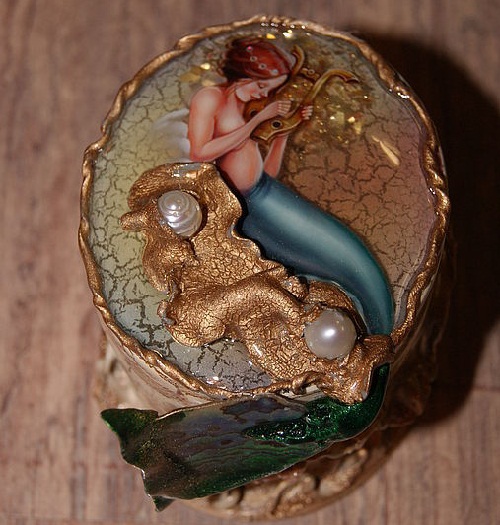Vintage Mermaid jewellery

French pendant, circa 1860-1870. Gold, enamel, foil set Burmese old cut rubies, pearl, mother of pearl. Vintage Mermaid jewellery
Vintage Mermaid jewellery
Great storyteller, Hans Christian Andersen romanticized mermaid pretty much, because originally it was just a creepy creature. The existence of mermaids has been known since ancient times. In Russia, mermaids were considered the drowned girls. Or the suicide girls who decided to end life because of unhappy love. It is believed that the biggest holiday for them is the night of July 7, when they come out of the water and dance. Mermaids are interested not only in mere mortals, but the powerful men.
Russian Emperor Peter I carefully studied the records of Christopher Columbus, who claimed to have seen with his own eyes the three beautiful maidens with fish tails, frolicking off the coast.
Mermaid has long been an inspiration for jewelers.
Mermaid (Merrow, Morrough, Moruach, Moruadh, Maighdean-mara, Ben-Varrey, Mary Morgan) – continental and insular folkloric figure. Half-human, half-fish beings are found in the folklore of all Celtic lands, from the west of Ireland across Scotland and England to the coasts of France. These figures most often appeared as female, although male merfolk are occasionally known. They had much in common with other half-human beings such as Swan Maidens and Seal people but had special powers as well.
A mermaid was a kind of sea fairy, an other-world creature who swam in shallow coastal waters, often with the intention of drawing humans into the brine and to their deaths. In some tales, mermaids did so because they found human men irresistibly attractive; in these tales they are typical fairy lovers. Their sweet singing lulled people to sleep wherever water could lap over them so they drowned; these figures may be confused with the classical siren, a death-messenger who appears as a bird as well as a singing maiden.
Vintage Mermaid jewellery
The Scottish islands are rich in mermaid folklore. On the Isle of Skye fair-haired people were said to descend from mermaids; members of the Morrow, MacMorrow, MacCodrums, and MacMurray families were their living relatives. In Orkney, off the northern coast of Scotland, a mermaid was recorded to have appeared in the sea in the 1890s, her milk-white body, long arms, and unnaturally tiny head visible from shore. In the Hebrides the mermaid did not sport a magical cap as in other lands; instead she had a magical belt that had to be stolen to tame her. Her descendants were said to have the gift (or curse) of foreseeing who would die at sea. In the Shetlands many people believed themselves descended from mermaids, pointing to a small membrane between fingers and toes (actually a natural, although unusual, physiological mutation) as proof.
In Brittany mermaid appeared as a siren, luring men to their deaths in treacherous waters. Their leader was the pagan princess Dahut, who floated above her submerged city of YS and sang beautifully to passing sailors. Should a man venture toward her, however, he drowned in the wild ocean waves. Dahut, whose legend describes her murderous love for men, may have been a mermaid before being depicted as a princess, or the opposite may be true. In some parts of Brittany it was said that all mermaids are daughters of Dahut.
In England mermaids were associated with freshwater as well as the ocean; the LAKE MAID¬ENS did not live in running water but only in pools and other still water.
Kirks Folly mermaid jewelry:
































